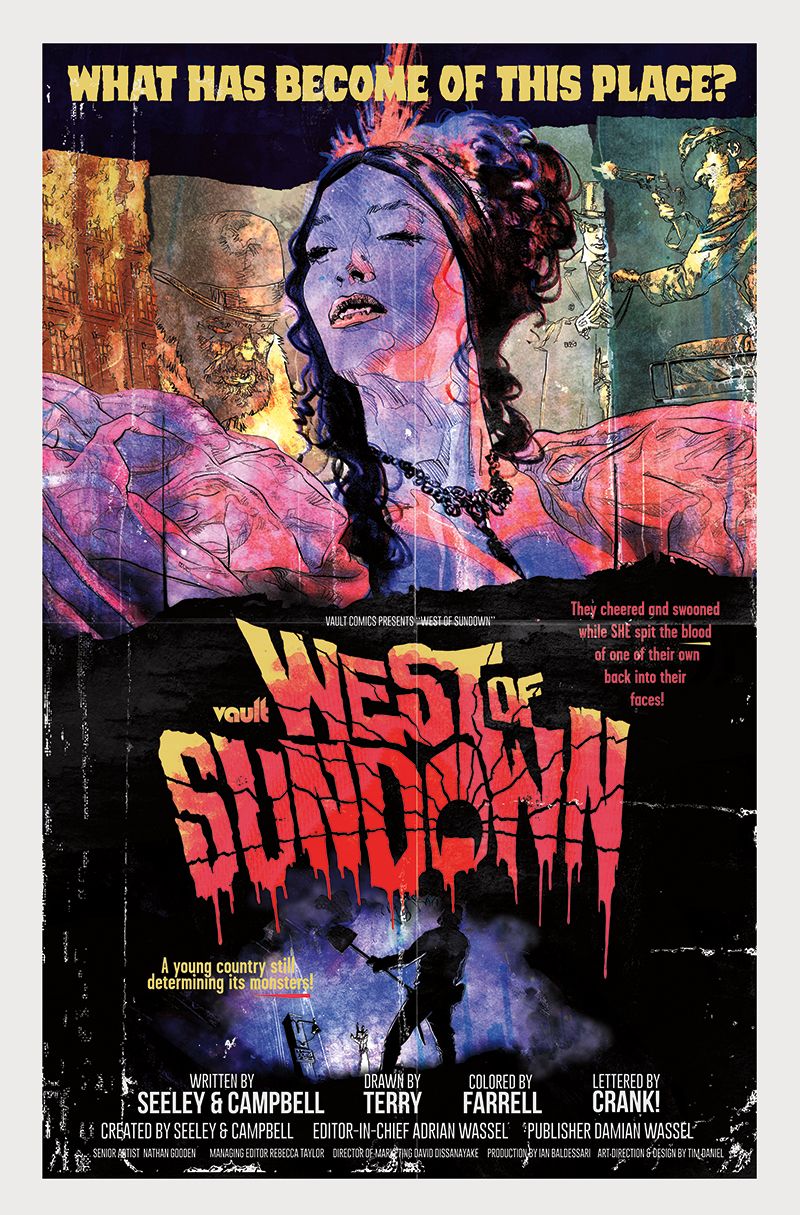Vault's West of Sundown #1
- Artist
- Jim Terry
- Colorist
- Triona Farrell
- Cover Artist
- Tim Daniel, Aaron Campbell
- Letterer
- Crank!
- Price
- 3.99
- Publisher
- Vault Comics
- Release Date
- 2022-04-06
- Writer
- Tim Seeley, Aaron Campbell
DC Comics veterans Tim Seeley and Aaron Campbell have penned their own original story, an ambitious amalgam of vampire thriller, monster horror, and Old Western, debuting this week from Vault Comics. Besides its illustrious writing team, West of Sundown #1 is created by artist Jim Terry, with colors by Triona Farrell and letters by Crank!. The cover touts a vintage monster story, framed by expressionistic art, gorgeous enough that many people will be buying this comic based on the outward aesthetic alone.
West of Sundown #1 follows the unexpected and untimely waking of vampire Constance Der Abend midway through a civil war she had very much intended to sleep through. Stumbling across her resting place, Dooley O'Shaughnessy, a confederate soldier without a cause, jumps at the opportunity to bail out of the war and become a full-time vampire manservant. When an unfortunate twist of fate drives them out of their fashionable New York upper-crust life, the pair must return to Constance's homeland of New Mexico to a much-changed landscape teeming with threats and lurking monsters.

Seeley and Campbell have delivered an extremely functional prologue to their vampire Western, although largely devoid of the kind of flair or style expected from the intersection of two incredibly dramatic genres. The plot itself has admirable clarity, but there is very little wit or elegance to the dialogue, especially with such colorful characters to play with. The dynamic between Dooley and Constance is touching, arguably the most interesting and novel part of the whole comic. Their relationship, somewhere between maternal and benevolent god, feels authentic and has lots of room to grow. Disappointingly, West of Sundown #1 does little to add to or complicate existing vampire lore, dealing mostly in already overplayed stereotypes with a pale, dark-haired rich socialite who feeds off only those who deserve it. The twist of Constance's homeland and its importance is a much-needed detail that makes the story infinitely more memorable. Perhaps West of Sundown is hoarding its best and most inventive ideas for later in the story, which would only suggest some problems with the first issue's pacing and judgment.
The art, all produced by Terry, presents some of the strongest moments of West of Sundown #1. His depiction of Constance is appropriately inhuman in her perfection. Frequently the humans appear monstrous in contrast to her, a fascinating subversion waiting to be experimented with. The expressionist style of the cover is scarcely visible in the comic itself, generally working in much more conventional lines, which adds to the clarity but detracts from the distinct mood the comic is trying to set. The two-page spreads are the most artistically ambitious moments of the issue, with smaller undefined panels looping around a centerpiece in a way that feels chaotic and miasmic in equal measure, to stunning results.
Farrell's colors are understated, often softened and neutral even in intense moments. The sepia undertone sells the vintage angle, making the comic feel like it is moving through the lens of the past. However, it means that any expectations built from the gorgeous cover of an ethereal, experimental visual experience are disappointed, met instead with a more lifelike and pedestrian approach. The letters, courtesy of Crank!, add a huge amount of much-needed dimension to the dialogue. The sound effects are also very well considered. The choice to change up the lettering for Dooley's internal monologue does a great job of setting a tone for the comic's second half and communicating more about Dooley's personality.
West of Sundown #1 has all the ingredients to be a terrific horror/Western, but the debut issue lacks edge or bite. There are moments of visual flair or satisfying character development, but overall, it fails to shock or awe or deliver on the aesthetic hinted at by the cover art. The comic's conclusion promises that conflict is just around the corner, and this team has put together an intriguing enough premise to make the next installments worth investigating.



